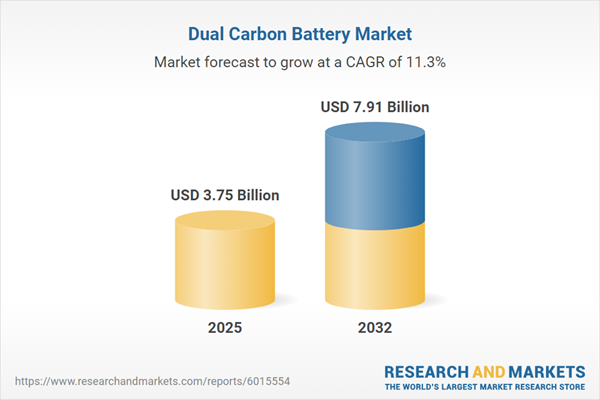Speak directly to the analyst to clarify any post sales queries you may have.
The dual carbon battery market is emerging as a strategic focus for organizations seeking advanced, sustainable energy storage. As market pressures evolve, senior executives must understand the leading trends, sector shifts, and innovation pathways shaping this environment.
Market Snapshot: Dual Carbon Battery Market Size and Growth
The global dual carbon battery market is experiencing substantial momentum, with a forecasted increase from USD 3.37 billion in 2024 to USD 3.75 billion in 2025, reaching USD 7.91 billion by 2032. This trajectory reflects a compound annual growth rate of 11.26%. Adoption is driven by the need for recyclable, thermally stable, and energy-efficient batteries across consumer electronics, automotive, grid infrastructure, and industrial applications. Investments in innovative electrode materials and ongoing improvements in manufacturing processes are strengthening the supply chain and driving sector expansion. Market interest continues to amplify as organizations seek both performance and sustainability from energy storage technology.
Scope & Segmentation: Comprehensive Industry Coverage
This analysis equips executives to identify growth pathways and benchmark performance within the dual carbon battery ecosystem. The study offers detailed insights across multiple segments to enable informed decision-making:
- Product Format: Cylindrical, pouch, and prismatic batteries, enabling versatile deployment in both compact electronics and high-capacity energy storage systems.
- Application Areas: Consumer technologies such as wearables and smartphones; electric mobility including passenger and commercial vehicles; large-scale energy storage; and tools for industrial environments—a broad range aligned to critical market needs.
- Cell Capacity Range: Compact cells tailored for small devices, mid-capacity options for everyday use, and high-capacity units suitable for demanding automotive or industrial loads.
- End Use Segments: Focus on the automotive sector, commercial operations, industry, residential applications, and renewable energy integration, each with its own growth dynamics and technology preferences.
- Geographical Regions: In-depth assessment of the Americas, Europe, Middle East & Africa, and Asia-Pacific, with specific insight into China, India, Japan, and Australia to reflect local regulatory and policy conditions influencing adoption.
- Company Developments: Assessment of leading manufacturer initiatives and technology partnerships, providing an actionable benchmark for senior leaders navigating the evolving value chain.
Key Takeaways for Senior Decision-Makers
- Advances in carbon nanostructure engineering are enabling improved battery efficiency and recyclability, serving the demands of both mobile and stationary storage projects.
- Industry collaboration—linking manufacturers, research entities, and integrators—is shortening innovation cycles and expanding the potential for market-ready battery solutions.
- Technological integration, such as digital twin modeling and smart production lines, is elevating product quality and supporting flexible, responsive supply chains.
- Circular economy practices and supply chain transparency are shaping regulatory adherence and accelerating market entry in new and established regions.
- Strategic sourcing of graphene and recycled carbon is decreasing procurement risk by addressing fluctuation in supply and cost for critical battery components.
- Market demands are diverging: electronics markets prioritize miniaturization and energy density, while automotive and grid-storage applications focus on safety and effective heat management.
Tariff Impact on Dual Carbon Battery Supply Chains
Recent United States tariff policies are compelling industry participants to revise procurement and logistics strategies. As a result, many firms are strengthening local supply bases, expanding nearshore manufacturing capacity, and investing in domestic production facilities. These responses aim to counteract cost pressures and regulatory unpredictability, ensuring continuous supply and improved responsiveness as market conditions shift.
Methodology & Data Sources
This report is grounded in direct interviews with decision-makers and technical leads, as well as verifiable data from battery producers. Supplementary research incorporates scholarly articles, patent filings, and supplier documentation. Estimation methods involve triangulating and cross-validating findings to maintain reliability and sector relevance.
Why This Report Matters for Executive Strategy
- Enhances capital allocation and planning by providing in-depth analysis of evolving supply chains and emerging commercial opportunities.
- Delivers clear market segmentation and actionable opportunity maps to inform executive priorities and boost competitiveness.
- Empowers leaders with timely updates on regulatory landscapes and technological change, enabling informed risk management and trend adoption.
Conclusion
This report guides senior leaders through the dual carbon battery sector, offering concise direction on new drivers, technology shifts, and best practices for proactive risk mitigation and opportunity capture.
Additional Product Information:
- Purchase of this report includes 1 year online access with quarterly updates.
- This report can be updated on request. Please contact our Customer Experience team using the Ask a Question widget on our website.
Table of Contents
3. Executive Summary
4. Market Overview
7. Cumulative Impact of Artificial Intelligence 2025
Companies Mentioned
The companies profiled in this Dual Carbon Battery market report include:- Contemporary Amperex Technology Co., Ltd.
- Faradion Limited
- Natron Energy, Inc.
- HiNa Battery Technology Co., Ltd.
- Tiamat SAS
- Altris AB
- Farasis Energy (Ganzhou) Co., Ltd.
- SVOLT Energy Technology Co., Ltd.
- Samsung SDI Co., Ltd.
- LG Chem Ltd.
Table Information
| Report Attribute | Details |
|---|---|
| No. of Pages | 181 |
| Published | November 2025 |
| Forecast Period | 2025 - 2032 |
| Estimated Market Value ( USD | $ 3.75 Billion |
| Forecasted Market Value ( USD | $ 7.91 Billion |
| Compound Annual Growth Rate | 11.2% |
| Regions Covered | Global |
| No. of Companies Mentioned | 11 |









